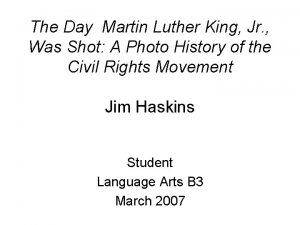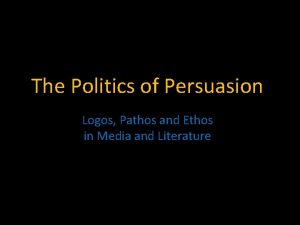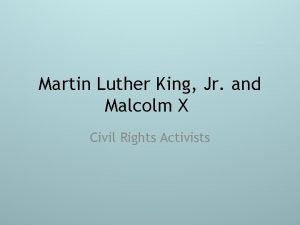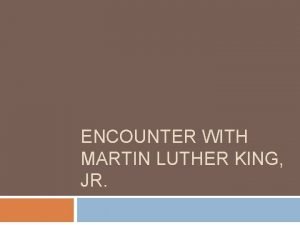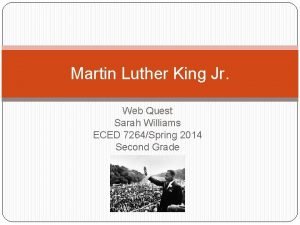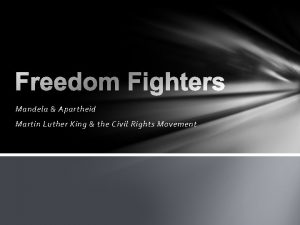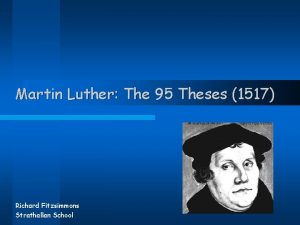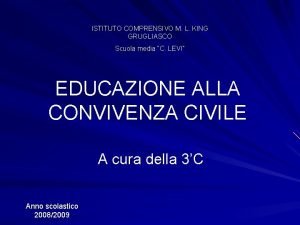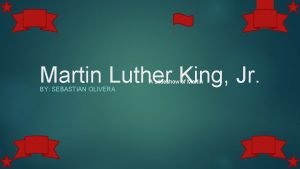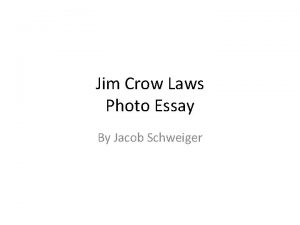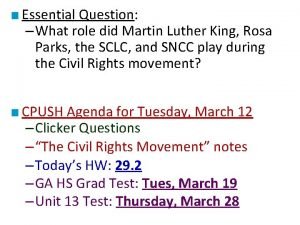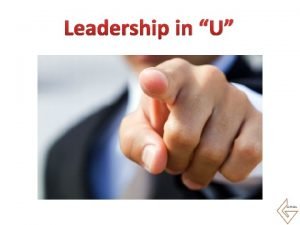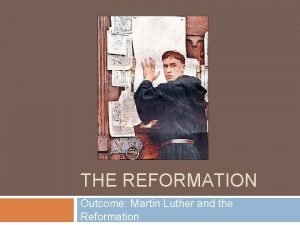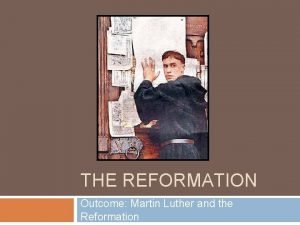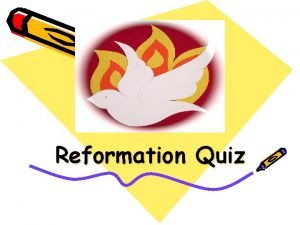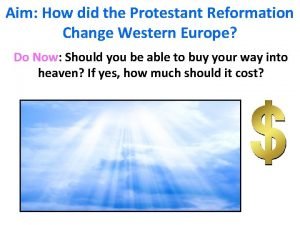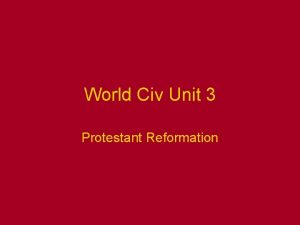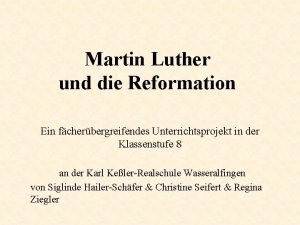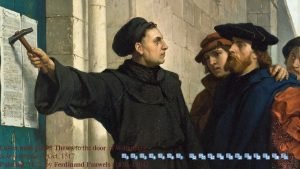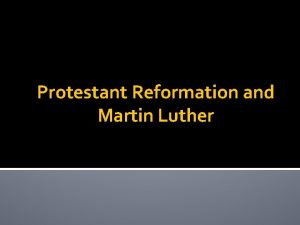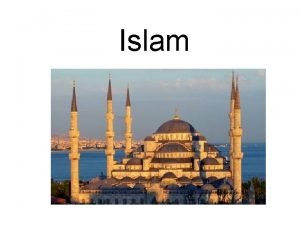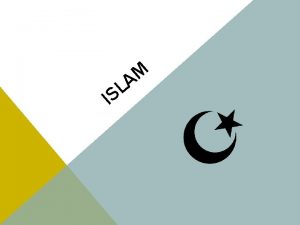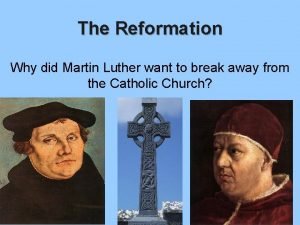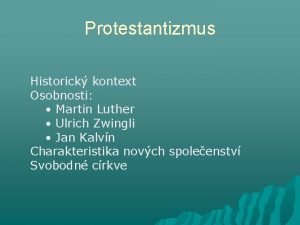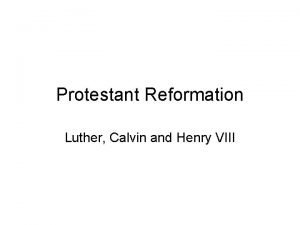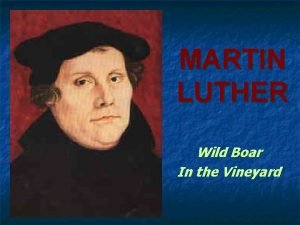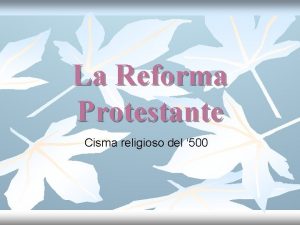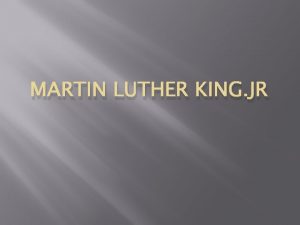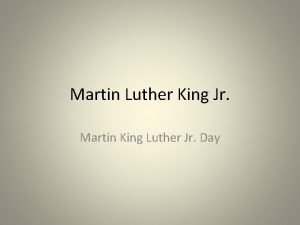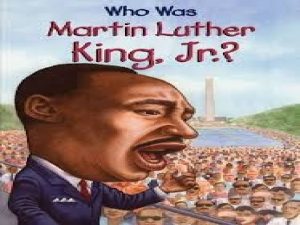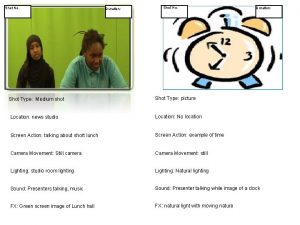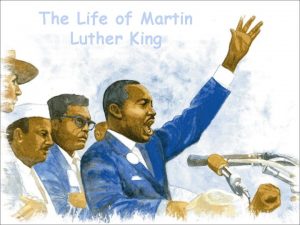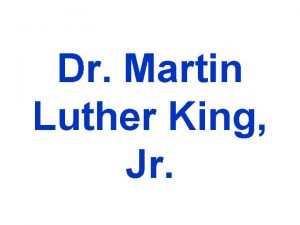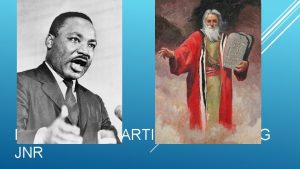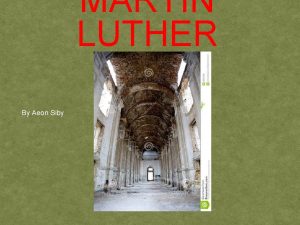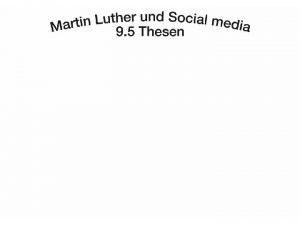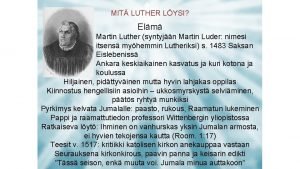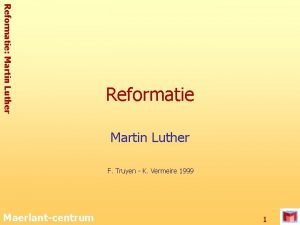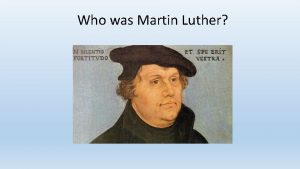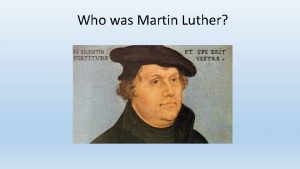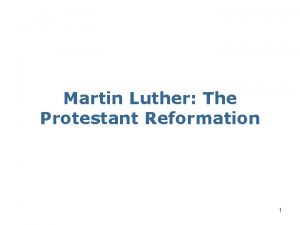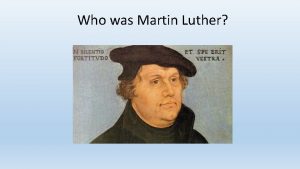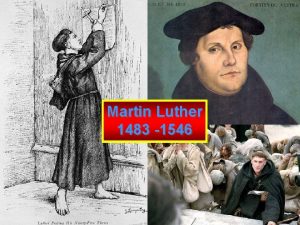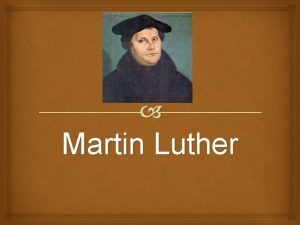The Day Martin Luther King Jr Was Shot


































- Slides: 34

The Day Martin Luther King, Jr. , Was Shot: A Photo History of the Civil Rights Movement Jim Haskins Student Language Arts B 3 March 2007

Chapter 1 and “End of an Era” • • Who: Dr. Martin Luther King, Jr. What: was assassinated When: April 4, 1968 Where: balcony of the Lorraine Motel in Memphis , TN • How: shot in the head by James Earl Ray piercing his spinal cord • Why: thinking his death would end the Civil Rights Movement • Summary of chapter:

Chapter 2 and “The Earliest Fighters for Freedom” • • Who: Africans captured for slavery What: fought for their freedom When: up to the 19 th. C Where: on the slave ships How: mutinied, committed suicide Why: to avoid being slaves Summary of chapter:

Chapter 3 and “Slave Resistance in North America” • Who: Stono Rebellion, Christian slaves, Nat Turner, Denmark Vesey, preachers • What: trying to gain freedom • When: 1739 -1839 • Where: SC, Virginia, Mississippi • How: armed rebellion, " pidgin” English, drums, feet beats, spirituals with secret messages; preacher rebellions • Why: resist slavery • Summary of chapter:

Chapter 4 and “Freedom for the Colonies” • Who: Slaves, Crispus Attucks, members of the Church of Christ, James Forten-Freed slaves • What: fought during the Revolutionary War and desired to be part of the constitutional process • When: 1770 -1776 • Where: North – Mass. and New England • How: letters, petitions demonstrations, fought as soldiers • Why: equal rights when the constitution was first written • Summary of chapter:

• • Chapter 5 and “The African American Church” Who: David George, Richard Allen, Absalom Jones, Peter Williams, and James Varick. What: freedmen founded (created) a black church where they lived. Later they all formed the black Masonic Lodge for Pennsylvania. When: 1773 -1816 Where: South Carolina (David George), Philadelphia (Richard Allen and Absalom Jones), New York (Peter Williams and James Varick) How: , they formed churches for blacks. Why: The blacks were not allowed to pray in the white churches. Summary of chapter:

Chapter 6 and “The Abolitionist Movement ” • Who: Fredrick Douglass, John B. Russwurm, Samuel E. Cornish, David Walker, William Lloyd Garrison, Harriet Beacher Stowe, Sojourner Truth, and James Forten abolitionists • What: They all wanted to abolish slavery • When: 1800 -1847 • Where: New England • How: They wrote letters, novels, newspapers, and they held protests. • Why: It was to impact individual states to stop slavery. • Summary of chapter:

Chapter 7 and “The Underground Railroad” • Who: Harriet Tubman; John Brown • What: She helped slaves escape to Canada; Organized a rebellion • When: , 1848 -1858; October 16 th 1859 • Where: South to Canada; Harpers Ferry • How: She traveled through the Underground Railroad; attacks the arsenal • Why: To free slaves from the south; to arm slaves • Summary of chapter:

Chapter 8 and “The War Between the States” • • Who: Lincoln, black soldiers, Smalls What: were freed and fought for the Union When: 1863 -65 Where: North and South How: fighting for the Union Why: to gain freedom for the slaves Summary of chapter:

Chapter 9 and “Reconstruction” • Who: Freed slaves and politicians: KKK • What: endeavor to adjust to freedom of those slaves: endeavored to intimidate blacks • When: after the Civil War is over • Where: in the South • How: by giving freemen the vote, 40 acres and a mule, voting blacks into office; through terrorism • Why: to adjust to being free with little or no education or property; to keep them from obtaining power • Summary of chapter:

Chapter 10 and “Jim Crow” • Who: Southern legislators • What: passed restrictive laws called the “Jim Crow” laws • When: after Reconstruction • Where: in the South • How: voting out black office holders • Why: to enforce segregation • Summary of chapter:

Chapter 11 and “Fight or Leave” • Who: B. T. Washington; W. E. B. Du. Bois • What: educate freed slaves to exist in the agricultural South; integrate and educate in fields other than agriculture • When: 1881 -1911 • Where: South; North • How: building black colleges (A and M) in the South , A and M skills developed; integrate and attend basically any college by forming interracial groups like the NAACP and National Urban League • Why: educate blacks in the skills they have without integrating and fight the Southern system; races to work together • Summary of chapter:

Chapter 12 and “Black and the Press” • Who: Ida Wells Barnett; Marcus Garvey • What: use the press to present the truth through black newspapers; “Go back to Africa” • When: 1890 -1927 • Where: Memphis; America • How: use the press to form a campaign • Why: coverage to larger audience; let us return to where we can obtain freedom. • Summary of chapter:

Chapter 13 and “War and Peace” • Who: W. C. Handy, Langston Hughes; black soldiers • What: created a black culture in the Harlem Renaissance; demanded to fight for freedom and wanted freedom • When: 1888 -1920 s • Where: Harlem, NY; Europe in WW 1 • How: performed in places like The Cotton Club; they fought for America and demanded upon return rights they fought for • Why: in North support of white society; wanted the same rights as whites • Summary of chapter:

Chapter 14 and “The Depression and the New Deal” • Who: Adam Clayton Powell; Randolph (NAACP); “Scottsboro Boys” • What: try to gain rights for blacks; trying to gain freedom from a crime they didn’t commit • When: 1929 -40 s • Where: Harlem; Alabama • How: sought protest; sought legal representation • Why: same rights as whites; falsely accused • Summary of chapter:

Chapter 15 and “World War II` • Who: A. Phillip Randolph, Bayard Rustin, James Farmer • What: started; tried to get racial equality CORE; • When: 1938 -50 • Where: Washington, DC; Chicago; • How: went to Roosevelt and Truman who gave executive orders; protest through sit-ins • Why: racial equality allowing blacks to work on government projects and have the military integrated. • Summary of chapter:

Chapter 16 “With All Deliberate Speed” Who: Thurgood Marshall; NAACP: Supreme Court; Linda Brown What: desegregate schools When: 1950 -70 s Where: Topeka, KS How: Brown vs The Topeka, KS Bd of Educ. Why: to challenge the separate but equal policy which was unfair to blacks.

Chapter 17 and “Non-Violent Protest” • • • Who: Rosa Parks, MIA, NAACP, SCLC, MLK, Jr. What: boycotted, used non-violent protests When: 1955 -57 Where: Montgomery, AL How: not riding busses, Civil rights Act of 1957 Why: desegregate the busses to prove to the white society blacks were necessary to their economy • Summary of chapter:

Chapter 18 and “Sitting and Riding” • • • Who: SNCC, MLK, Jr. SCLC, CORE, What: had sit-in and freedom rides When: 1960 s Where: South How: took seats from whites; rode busses previously segregated • Why: to desegregate • Summary of chapter:

Chapter 19 and “Marching for Freedom” • Who: Bayard Rustin, A. Phillip Randolph, JFK, LBJ, MLK, Andrew Goodman • What: looked for a path to freedom • When: 1960 s • Where: Washington, DC; Dallas, MS. • How: freedom marches and Civil Rights Act, registering black voters • Why: motivate the movement for jobs and freedom • Summary of chapter:

Chapter 20 and “Black Power” • • Who: SNCC, Stokely Carmichael, Malcolm X What: formed a more militant approach When: 1965 -69 Where: Chicago, NY, CA How: forming organizations that promoted Black pride and power Why: tired of the way young blacks who were non-violent were being beaten • Summary of chapter:

Chapter 21 and “On From Selma” • Who: MLK, Jr. And SCLC; SNCC • What: marched from Selma to Montgomery, AL: Watts, LA • When: March, 1965; • Where: Alabama: LA • How: non-violent demonstration: riots • Why: to assure voting rights; to protest • Summary of chapter:

Chapter 22 and “Blacks in Office” • Who: Black politicians • What: voted into offices like mayor, gov. , congress, Supreme Court; run for Pres. • When: 1970 -1990 • Where: North, but also eventually in the South • How: through programs like affirmative action and voting for change • Why: wanted changes for more political power • Summary of chapter:

Chapter 23 and “The Struggle Goes On” • Who: Black people • What: still struggle to honor what MLK, Jr. protested for non-violently • When: 21 st Century • Where: all over the world ( Africa) • How: to be an example for people all around the world • Why: to keep segregation from existing • Summary of chapter:

Important Dates through Civil War • 1618 – first slaves in America • 1820 – Missouri Compromise enacted, banning slavery to the or of southern boundary of Missouri • 1831 - First abolitonist newspaper, Liberator • 1854 – Kansas-Nebraska Act – repeals Missouri Compromise and opens North to slavery • 1857 – Dred Scott Decision – denies citizenship to American blacks • 1863 – Emancipation Proclamation

Important Dates After Civil War through 19 th C • 1865 – Thirteenth Amendment abolishing slavery • 1866 – Civil Rights Bill passed • 1868 – Fourteenth Amendment – all person s born or naturalized in the United States are citizens and entitled to equal protection of its laws • 1870 – fifteen Amendment – Right to vote regardless of race or previous condition of servitude (not women though) • 1875 – Civil Rights Bill giving blacks the right to equal treatment in public places and transport • 1883 – 1975 Civil Rights Act declared unconstitutional beginning Jim Crow Laws • 1896 – Plessy v Ferguson doctrine upholds Separate but Equal

Important Dates of first half of 20 th Century • 1909 – NAACP ( National Association for the Advancement of Colored People) founded by W. E. B. Du Bois • 1910 – National Urban League Founded • 1941 - F. d. Roosevelt signs Executive Order 8802 forbidding discrimination in war industries • 1942 – CORE ( Congress of Racial Equality) • 1946 – Congress bans segregation on interstate buses • 1946 – President Truman creates Committee on Civil Rights • 1947 – CORE sends first “Freedom Riders” • 1948 – President Truman issues Executive Order 9981 directing equality of opportunity in the armed forces

Important Dates of second half of 20 th Century • 1951 – NAACP attacks “separate but equal” • 1954 - Brown v the Topeka, KS Board of Education • 1956 – U. S. Supreme Court banning segregation on Montgomery, AL city buses after boycott from the action of Rosa Parks • 1960 – SNCC ( Student Nonviolent Coordinating Committee) formed • 1964 – Civil Rights Act signed by President Johnson • 1968 – Civil Rights Act banning discrimination housing and making it a crime to interfere with civil rights workers signed • 1971 – US Supreme Court rules in Swann v Charlotte –Mechleberg so busing can achieve integration • 1978 – Bakke case rules affirmative action with strict action quotas is illegal • 1990 – Pres. Geo Bush vetoes Civil Rights Act

Know these important People • • • Crispus Attucks Nat Turner Joseph Cinque Sojourner Truth Frederick Douglass Harriet Tubman John Brown Booker T. Washington W. E, B. Du. Bois Marcus Garvey Mary Mc. Leod Bethune Adam Clayton Powell • • • • Linda Brown Thurgood Marshall Rosa Parks Martin Luther King, Jr. Medgar Evers Malcolm X Viola Liuzzo Stokely Carmichael Carl Stokes James Charles Evers Andrew J. Young Jesse Jackson L. Douglas Wilder David Dinkins

Firsts prior to 10 th C 1663 – First serious slave conspiracy 1770 – Crispus Attucks – first black killed in Revolutionary war 1775 – First abolitionist organization formed in US 1775 – First black Baptist Church founded 1777 - Vermont the first state to abolish slavery 1827 - Freedom’s Journal, first black newspaper 1830 – First national black convention presided by Richard Allen 1847 – First issue of Frederick Douglass’s North Star 1863 – Mass. recruits first black soldiers 1867 – First meeting of the Ku Klux Klan 1868 and 72 – Louisiana has first blacks as Lt. Gov and acting Gov. 1870 – first black in the US House of Representatives – Jooseph Rainey 1881 – first black college (Tuskegee Institute) founded by Booker T. Washington

Firsts in 19 th Century 1936 – First NAACP suit – involves equal pay for black teachers 1936 – First women appointed as Director of Negro Affairs of the National Youth Administration 1941 – first Army Air Corps squadron for black cadets 1941 - First black bus drivers etc. hired in New York City 1944 – First black congressman from the East elected- Adam Clayton Powell 1947 – First freedom riders test ban on interstate travel segregation 1967 – First black on the Supreme Court – Thurgood Marshall 1968 & 1970 – First blacks elected to mayoral positions - Carl Stokes and Richard Hatcher; Kenneth Gibson 1977 – first black American ambassador to United Nations – Andrew Young 1984 – First black man to run for president – Jesse Jackson (? ) 1989 – first black governor – L. Douglas Wilder ; first black mayor of NYC

Organizations • • • 1775 – Black Baptist Church founded 1909 – NAACP founded 1942 – CORE founded by James Farmer 1957 – SCLC founded 1960 – SNCC founded

Chapter # and “Title” • • Who: What: When: Where: How: Why: Summary of chapter:

Bibliography Card • Haskins, Jim. The Day Martin Luther King, Jr. , Was Shot: A Photo History of the Civil Rights Movement. New York: Scholastic, Inc. , 1992.
 The day martin luther king jr was shot by jim haskins
The day martin luther king jr was shot by jim haskins Martin luther king jr life timeline
Martin luther king jr life timeline Work ethos
Work ethos Tretal stilfigur exempel
Tretal stilfigur exempel Malcolm x vs martin luther king
Malcolm x vs martin luther king Encounter with martin luther king jr by maya angelou
Encounter with martin luther king jr by maya angelou Brainpop jr martin luther king jr
Brainpop jr martin luther king jr Martin luther king apartheid
Martin luther king apartheid What was martin luther king
What was martin luther king Martin luther king 95 theses
Martin luther king 95 theses Istituto king grugliasco
Istituto king grugliasco Martin luther king jr slideshow
Martin luther king jr slideshow Jim crow photo essay
Jim crow photo essay Martin luther king and malcolm x venn diagram
Martin luther king and malcolm x venn diagram Leader vs manager
Leader vs manager Martin luther king of hinduism
Martin luther king of hinduism Day 1 day 2 day 3 day 4
Day 1 day 2 day 3 day 4 The reformation outcome: martin luther and the reformation
The reformation outcome: martin luther and the reformation What drove martin luther to write the 95 theses
What drove martin luther to write the 95 theses The protestant reformation quiz
The protestant reformation quiz Martin luther 95 theses summary
Martin luther 95 theses summary Unit 3 martin luther and the protestant reformation
Unit 3 martin luther and the protestant reformation Konzil von trient unterrichtsmaterial
Konzil von trient unterrichtsmaterial Martin luther nails 95 theses
Martin luther nails 95 theses Musikepochen zeitstrahl
Musikepochen zeitstrahl Unit 3: martin luther & the protestant reformation
Unit 3: martin luther & the protestant reformation Martin luther reformation political cartoon
Martin luther reformation political cartoon Trosbekännelse islam
Trosbekännelse islam Martin luther hz muhammed
Martin luther hz muhammed Martin luther
Martin luther Martin luther kritik
Martin luther kritik Marburské spisy
Marburské spisy John calvin and henry viii
John calvin and henry viii Martin luther obituary
Martin luther obituary Representantes de la reforma protestante
Representantes de la reforma protestante
